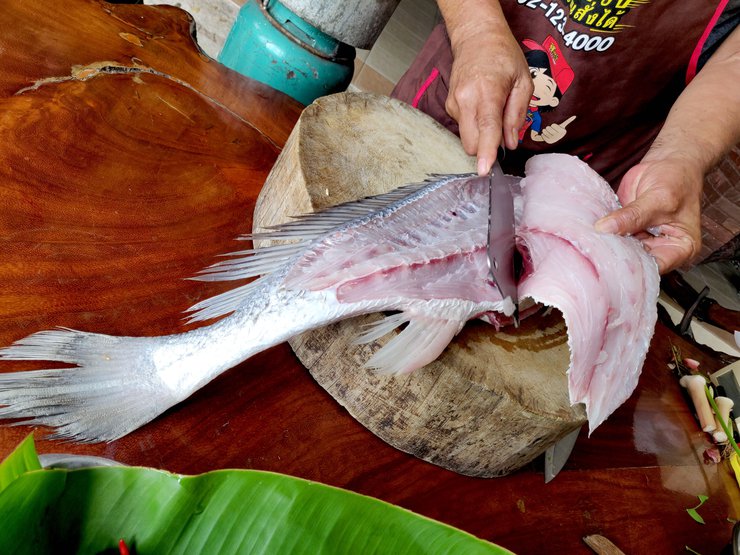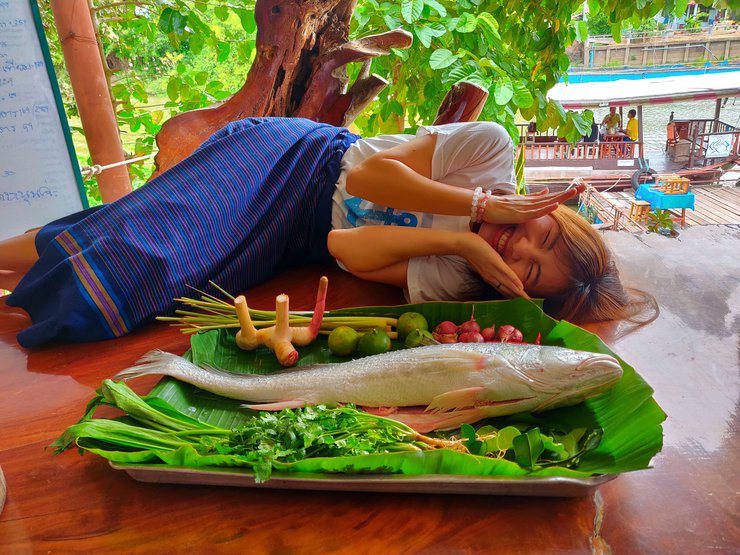If you happen to visit Bangkok like 20.5 million tourists do every year, then it’s easy to get lost in the glittery nightlife and forget Thailand’s age-old traditions. Green curry, pineapple fried rice and mango sticky rice steal the limelight at dinner tables and traditional Thai desserts like Khanom Tom Khao and Khanom Khan Hlaw have become a thing of the past.
Surprisingly, about 1.5 hours away from Bangkok, in a small village by the Suphanburi river, such traditions continue to flourish. On our second day at Ban Laem village, we had the opportunity to learn how to make various traditional Thai dishes and enjoy them by the river, while singing old songs, just like the fishermen used to.
Working our muscles to grind chilis
The set up looked perfect, good enough to even tempt people like me, who usually despise cooking, to give it a shot.
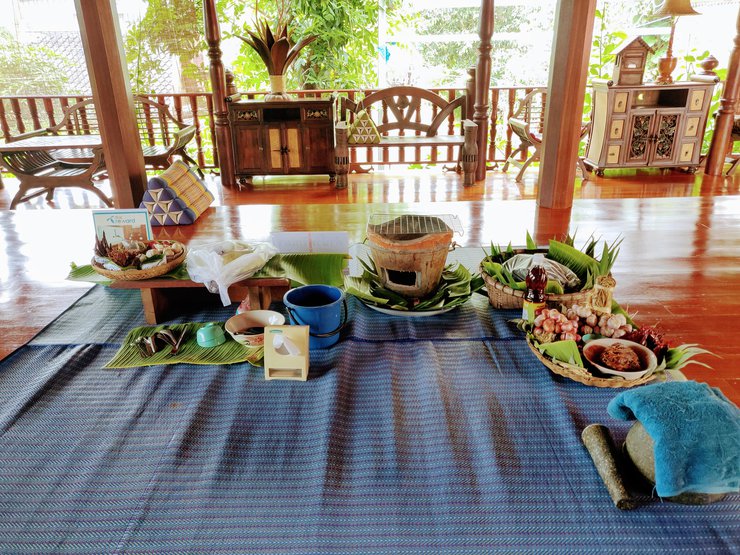
The first step of making chili paste is to pierce the chili through the middle with a thin bamboo stick. Continue to add chilis on this stick till it’s full. Next, roast the chilis as well as some onion and garlic on a clay stove. Fairly straight forward until now.
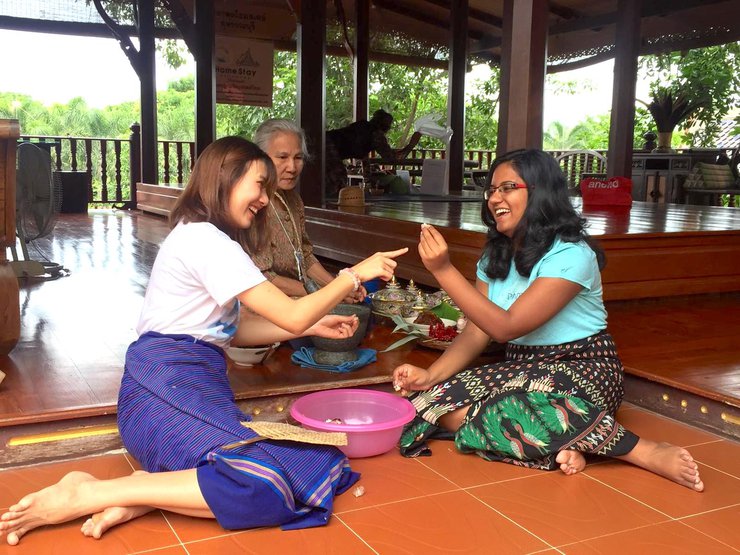
Now, we were told to take out the skin of the onions and garlic and put it in bowl with the chilis. Next step is to start grinding and keep grinding them together till it’s a fine mix. We kept working our muscles till our hands hurt. The old lady beside us was clearly stronger than us. She took the equipment from us and continued!
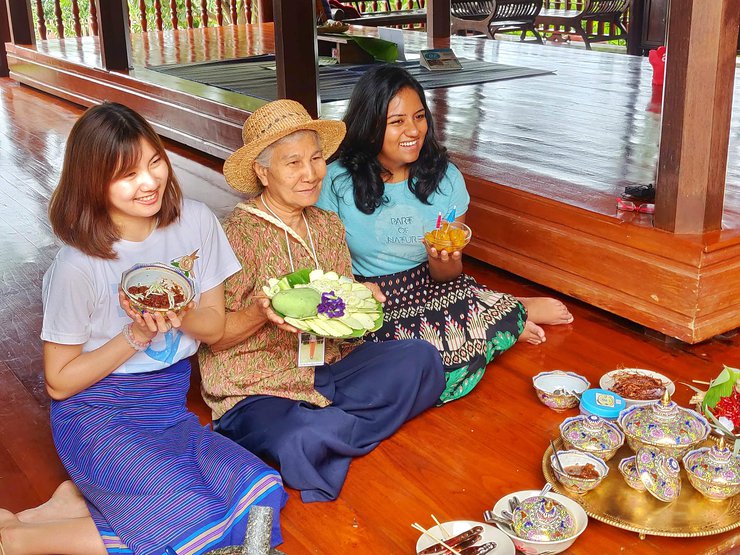
And Voila! Very soon our chili paste was ready!
Tom Yum, the Ban Laem way
Next, we hopped on to another cooking class, this time by the river. They had just caught a gigantic fish from the river and now it lays in front of us. I wondered what kind of fish it was.
“I don’t know the English name but translated from Thai it would mean Horse fish!”
“Why horse fish?” – I asked.
“Look at the scales on the side, it looks like the ones on a horse.” – Our local guide replied.
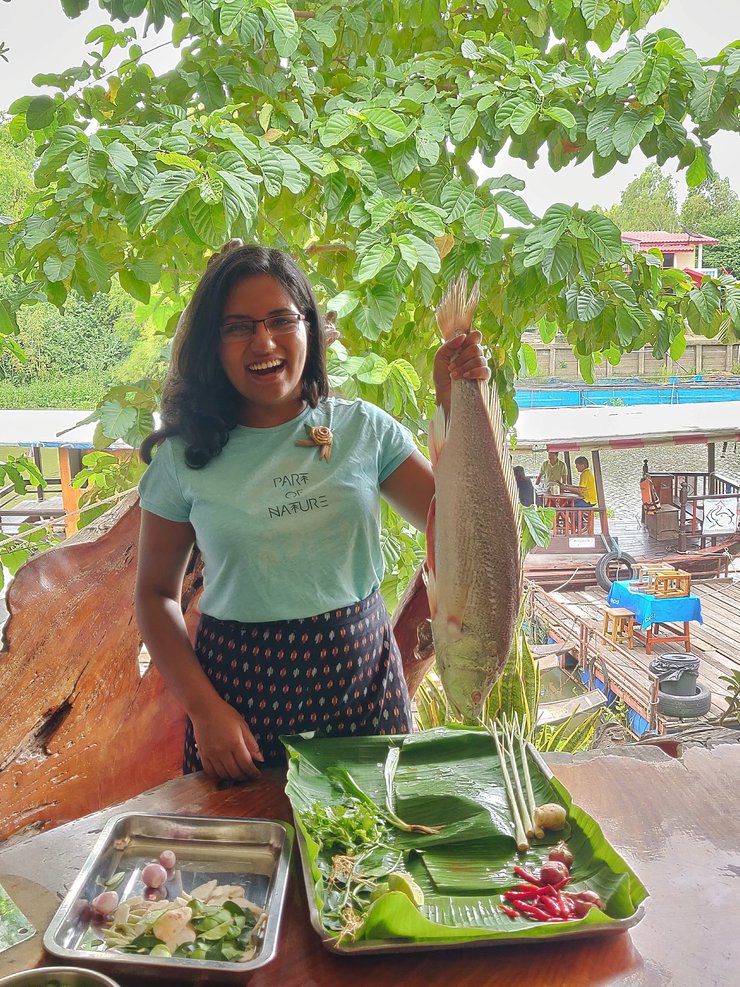
The fish weighed 3 kilograms and would cost about 1200 baht in the market. Later we found out it was a Boesemania fish. We played a quick game and told Sarunya (my Thai travel partner) to lie down beside the fish so we can compare their heights! Being the cute little girl she is, this was indeed an apt comparison.

Our chef went on to teach us how to chop various vegetables and squeeze lime juice. We put the vegetables to boil. Next part was the toughest one. We had to slice that enormous fish. Our chef skillfully started slicing at various angles, making the task appear rather simple. When we tried it for ourselves, we realized this was far from the truth. Nevertheless, with his help, we managed to slice them and boil them.

Now, here are the tricks, you have to put an appropriate amount of fish sauce and you must not stir the fish while it’s boiling – otherwise you end up with a fishy smell in your Tom Yum.
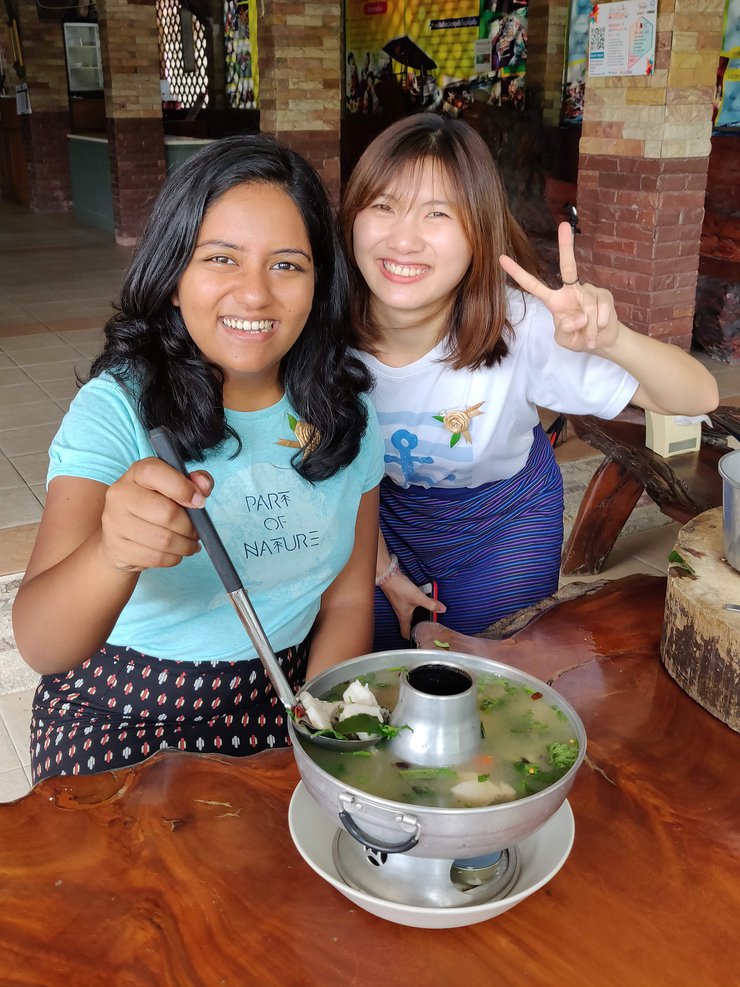
Making Tom Yum is fairly straightforward, once you have accomplished the task of chopping all the vegetables and the fish.
By the river, like the fishermen

After our hard work, we were rewarded with the pleasant experience of dining on the moving boat. As the boat ventured into the Suphanburi river, we came across numerous fishermen, their houses, schools, temples as well as the trees from which straws, bags and other goods are manufactured.
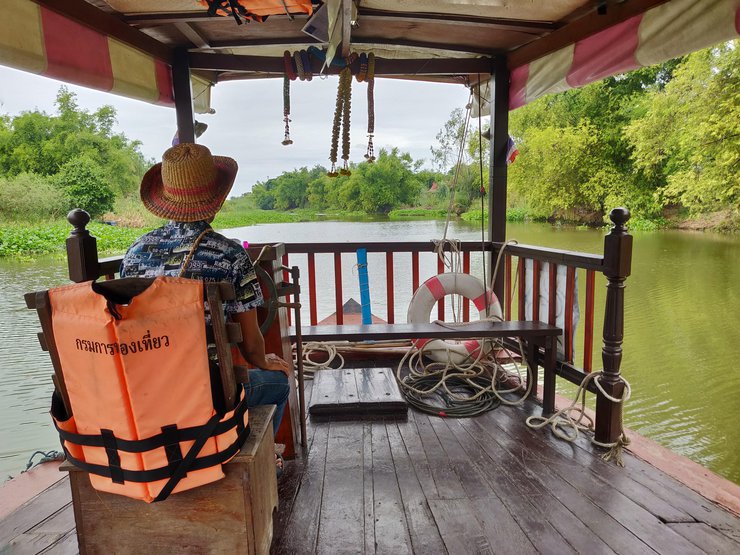
During the return journey, our host delighted us with a traditional song. I didn’t understand a single word but sometimes it’s not necessary. The tune conjured up an image of fishermen fishing and rowing their boats in my mind. Our local guide informed us that back in the days, there was no other form of entertainment, so the fishermen sang songs to keep themselves busy. “If a guy likes a girl, then he would sing for her too.” - My local guide added. We joked about how this norm would be highly ridiculed if any man dares to carry it out today! “We would call him crazy or something” – We all laughed.
There is something special about listening to fishermen songs & war stories, gliding along the Suphanburi river and letting the fresh wind mess up your hair. Suddenly, this bunch of modern-day travelers felt transported to a different era. And in this era, the Thai people ate a variety of lip-smacking desserts, not just mango sticky rice.
Khanom Chao Ban Chao Ruen – the Thai desserts that really deserve our attention
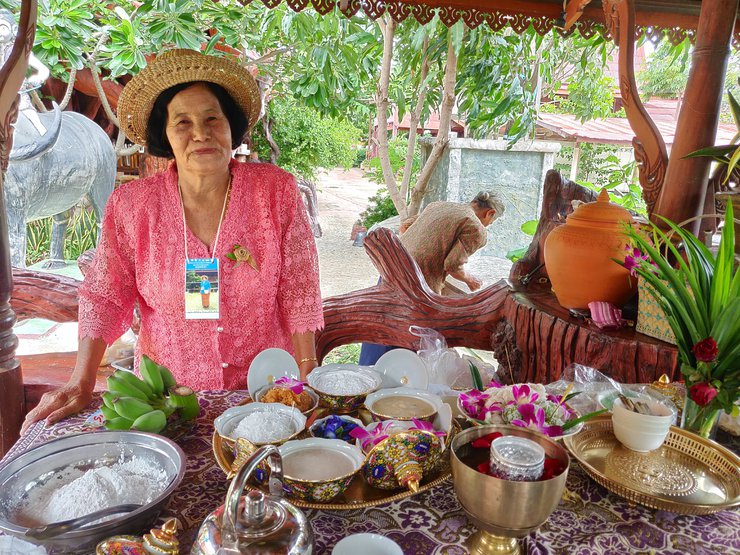
An elderly lady greets us with a broad smile. She has already made a few desserts and is waiting for us to make a few more. She has also decorated the entire setting with beautiful orchids.
Without further ado, we get started. We are going to make Khanom Khan Hlaw. We start boiling Pandan leaves and when it’s ready, we take a bit of the flavoured water and mix it with some flour. A bit of hot water and a bit of cold water needs to be added, I am told. As we continue to mix, the flour begins to get stickier. Now, it’s easier to form balls out of it. But before that, we must learn how to make colourful desserts.
Hot water is added to a special type of blue flower and as it mixes, the water turns blue. Adding lime juice on it darkens the colour! This coloured water is added to the flour mixture.
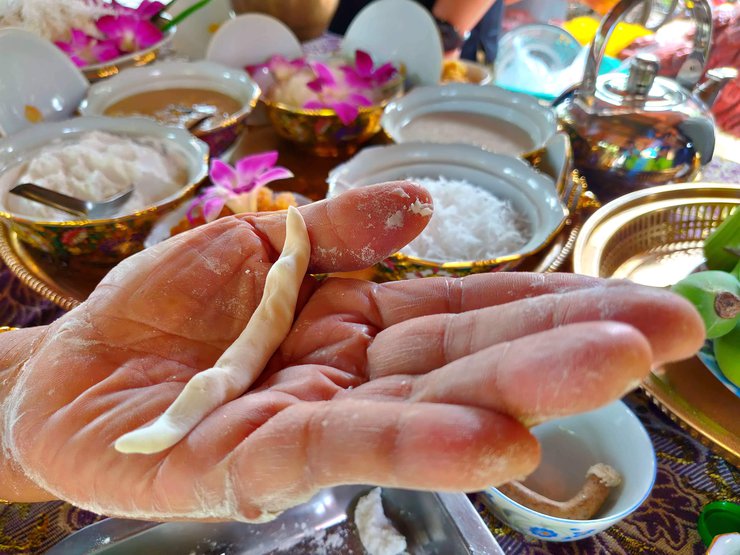
Now, we are ready to tear out small portions of the flour mixture and start rolling it to give it a thin cylindrical shape. She tells us to carve out two small portions – probably for visual purposes. Once this exercise is complete, we lower them to the boiling water. A few minutes later they are taken out.
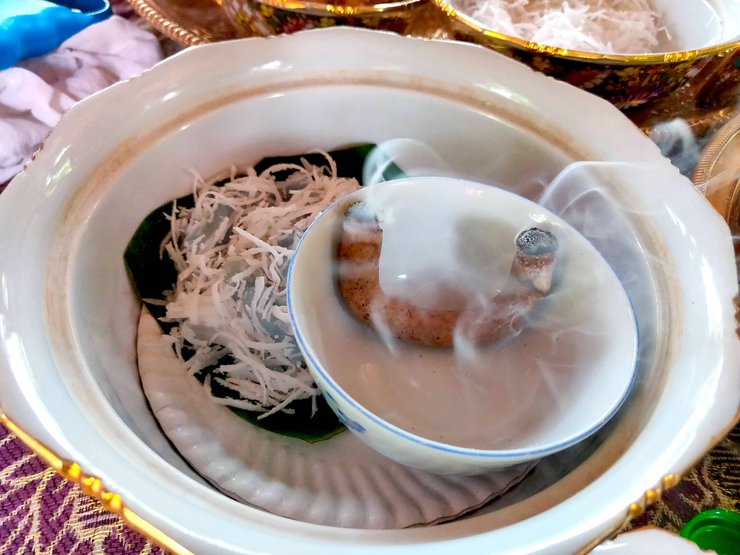
A shoe horse magnet shaped ingredient (of which no one quite recall the English name), known for its aroma, is burnt and placed beside the dessert in a closed box. The aroma transfers to the main dish and our Khanom Khan Hlaw is now ready!
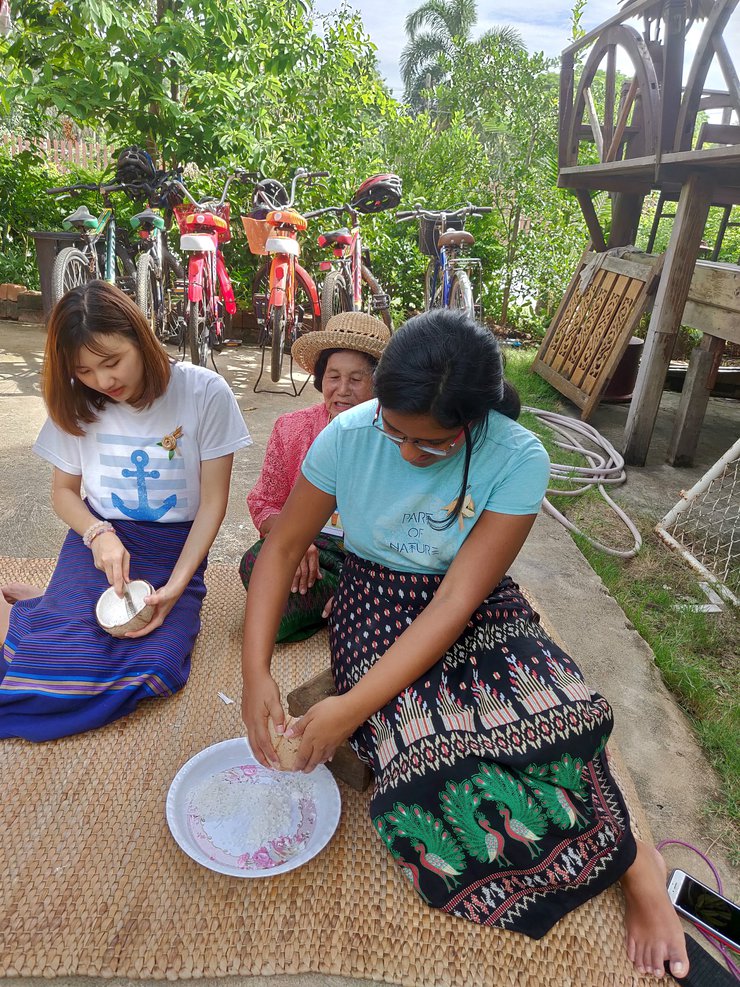
However, before we get to taste it, we have some more hard work ahead of us. We sit on an equipment which consists of a small flat surface attached to a blade. The idea is to rub the insides of the coconut on the blade. Not an easy task by any means!
Now comes the best part, tasting the delightful desserts. Khanom Tom Khao, Khanom Tom Dang, Khanom Khan Hlaw, coconut milk, and sticky rice. As I go around the plate and let my tongue taste each of these distinctly flavoured desserts, my heart is filled with happiness. Each of them tastes better than the previous one. The soul of a foodie is now at peace. My stomach is full, but I treat myself to one more round. After all, I’m a strong believer of eating what makes us happy digests the food faster!
Thong Pub – Thai crispy pancakes

You would think after all these, we are done with cooking classes but we are already being called upon by another lady. She is sitting behind what looks like a primitive version of a waffle maker. We are here to make tiny crispy pancakes.
Flour, a local variety of sugar, eggs, sesame seeds and coconut milk are mixed together to form the batter. A bit of the batter is spread on the pan of the equipment and the flipped over a couple of times. Very soon, the pancake is ready.
Now comes the real trick. Once you take the pancake out of the pan, immediately fold it two or three times and try to make it a cone. This is harder than you would expect. I failed miserably! But whether you get the cone shape or not, the pancakes are delicious as it is.
Thong Pub is yet another traditional Thai dessert that definitely deserves the world’s attention.
As our modern society races forward, many traditions are forgotten, and many aspects of our lifestyles change. Arguably, some of it change for the better but in the process, we lose a lot of valuable aspects of our life too. For instance, the idea cooking and eating together every day and truly enjoying each dish is an art that seems have gotten lost. The idea of sitting on a boat and singing traditional songs is a lifestyle that is quickly becoming extinct. And yet, when a city dweller like me delves into this quaint lifestyle, she finds herself experiencing emotions that she did not know she was capable of.
Madhurima Dutta
Friday, July 26, 2019 1:13 AM







